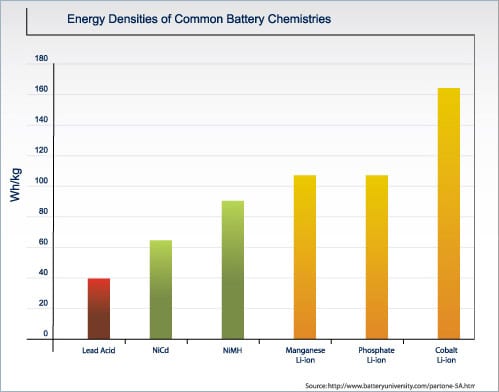gasoline is the champion at 47.5 MJ/kg and 34.6 MJ/liter; the gasoline in a fully fueled car has the same energy content as a thousand sticks of dynamite. A lithium-ion battery pack has about 0.3 MJ/kg and about 0.4 MJ/liter (Chevy VOLT). Gasoline thus has about 100 times the energy density of a lithium-ion battery. This difference in energy density is partially mitigated by the very high efficiency of an electric motor in converting energy stored in the battery to making the car move: it is typically 60-80 percent efficient. The efficiency of an internal combustion engine in converting the energy stored in gasoline to making the car move is typically 15 percent (EPA 2012). With the ratio about 5, a battery with an energy storage density 1/5 of that of gasoline would have the same range as a gasoline-powered car. We are not even close to this at present.Powering a car with electricity is considerably more efficient than powering a car with gasoline in terms of primary-energy consumption. While the efficiency of energy use of an electric car is very high, most power plants producing electricity are only about 30 percent efficient in converting primary energy to electricity delivered to the user. Conversion of petroleum to gasoline is highly efficient. This results in electricity having a factor of 1.6 improvement in use of primary energy relative to gasoline, and is an important point in its favor.A 2008 APS report on energy efficiency examined statistics on how many miles Americans drive per day. The conclusion of that study was that a full fleet of PHEVs with a 40-mile (60-km) electric range could reduce gasoline consumption by more than 60 percent. Thus America may not need a full fleet of BEVs to achieve a very considerable reduction in gasoline use.

Energy densities of common batteries
Cathode materials are comprised of cobalt, nickel and manganese in the crystal structure forming a multi-metal oxide material to which lithium is added. This family of batteries includes a variety of products that cater to different user needs for high energy density and/or high load capacity. The table below breaks down the most commonly used Lithium-ion battery cathode chemistries on the market into four groups: Cobalt, Manganese, NMC and Phosphate.

Energy densities of common batteries
Cathode materials are comprised of cobalt, nickel and manganese in the crystal structure forming a multi-metal oxide material to which lithium is added. This family of batteries includes a variety of products that cater to different user needs for high energy density and/or high load capacity. The table below breaks down the most commonly used Lithium-ion battery cathode chemistries on the market into four groups: Cobalt, Manganese, NMC and Phosphate.
No comments:
Post a Comment